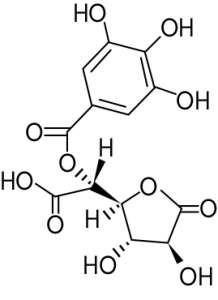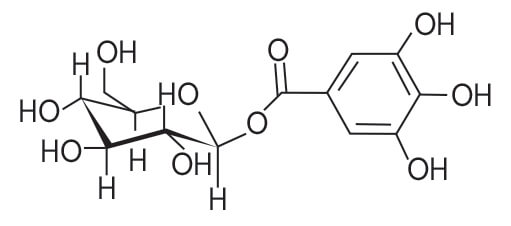Revisiting amla chemistry
To elucidate the bioactives responsible for the beneficial effects of amla, and their contribution towards its antioxidant activity, scientists at Sabinsa Corporation chose to revisit the chemistry of the Indian Gooseberry.
Tannin chemistry
The research team at Sabinsa Corporation developed a new HPLC method for the characterization and analysis of the various constituents of amla extract.
The aqueous extract of the fresh fruits of amla was separated using preparative reverse phase column chromatography, and the different fractions obtained were individually lyophilized and analyzed using various spectroscopic methods.

From the various spectroscopy investigations conducted it was concluded that the molecule previously reported as emblicanin A is actually β-glucogallin.
Similarly, the previously reported 2, 3, 4, 6-bis-(S)-hexahydroxydiphenoyl-2-keto-glucono-lactone (emblicannin B) is, in fact, mucic acid 1,4-lactone 5-O-gallate.
Other molecules identified include gallic acid and mucic acid methyl ester 2-O-gallates and ellagic acid.


The studies summarized above, led the research team at Sabinsa Corporation to believe that β-glucogallin and mucic acid gallates are the predominant active molecules in amla, and that these molecules are the significant contributors to the health effects of amla.
Investigating the ascorbic acid content in amla fruit extracts
The fraction corresponding to ascorbic acid peak was isolated by preparative HPLC and evaluated by mass and NMR spectroscopy. It was found that the fraction contained more than one compound which was different from ascorbic acid. It was resolved into four peaks using a modified LC-MS method. In addtion to ascorbic acid, the fraction was found to mainly contain mucic acid gallates.
In order to ensure that there was no chemical degradation of any ascorbic acid, the fresh juice of amla fruits was obtained and processed with optimum care. Various batches of fruits were processed under similar conditions and their ascorbic acid content was evaluated.
A variety of amla extract samples were studied and it showed either complete absence of ascorbic acid or trace amounts to a maximum of 4.0% w/w.
Even though ascorbic acid was not detected, Saberry® did show potential antioxidant activity. This indicated that ascorbic acid is not the most optimal biomarker that reflects the biological potential of amla. Thus, β-glucogallin is the more optimal and relevant biomarker that reflects the antioxidant potential of amla, more accurately than ascorbic acid.
